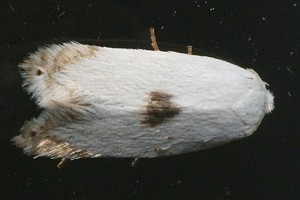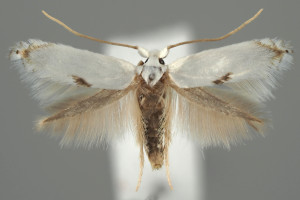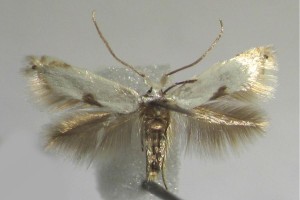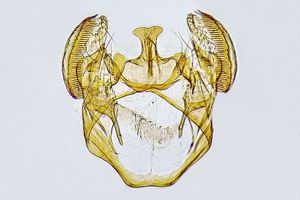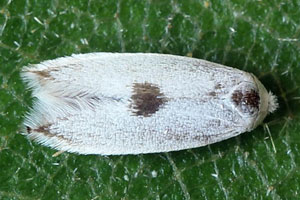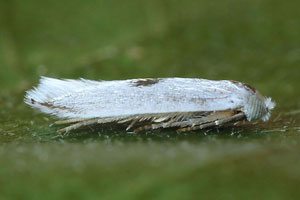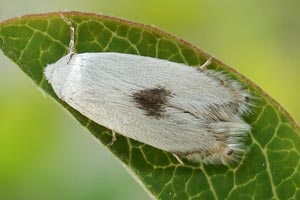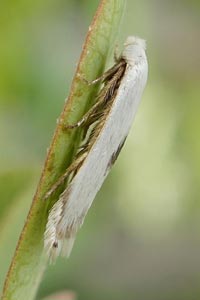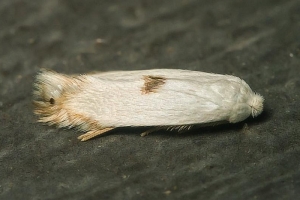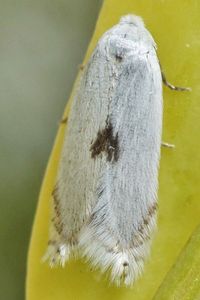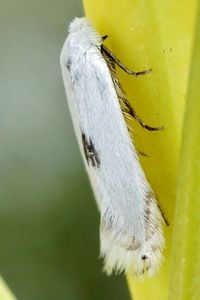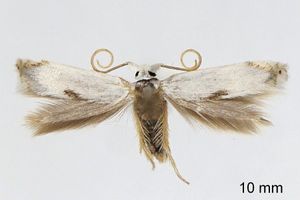

 +21Kontinente:EUAS
+21Kontinente:EUAS1. Lebendfotos
1.1. Falter
2. Diagnose
2.1. Männchen
2.2. Geschlecht nicht bestimmt
2.3. Genitalien
2.3.1. Männchen
2.4. Erstbeschreibung
Hinweis: Die grauschwarzen Partien der Vorderflügel auf diesem Bild waren ursprünglich weiß oder silberweiß, chemische Umwandlung des Farbstoffs Bleiweiß (siehe im Glossar).
3. Biologie
3.1. Nahrung der Raupe
- [Lamiaceae:] Lycopus europaeus (Wolfstrapp)
Nach Johansson et al. (1990) sind die alten Angaben zur Sumpfdotterblume (Caltha palustris) wenig glaubhaft. Plausibler ist da der Wolfstrapp (Lycopus europaeus), um den schon zahlreiche schwärmende Falter beobachtet worden sind. Doch die Autoren bleiben vorsichtig: "Such a confusion of hostplants could easily take place, where Caltha and Lycopus are frequently growing together. Without any more precise data, it is unwise to cite either of the two as hostplant of auritella." Doch während der Kontrolle der Druckfahnen zum Buch kam die erlösende Beobachtung: "Note added in proof. It can now be confirmed that Lycopus europaeus is the hostplant of auritella. On a locality in the Netherlands (Schinveld), where adults were taken in numbers, I observed in October 1988 very thin and Long barkmines in stems of Lycopus, which eventually lead to a few dead larvae, with headcapsules, very similar to known Opostegis larvae. The mines (with thin central frass) gradually enter deeper tissues of the stem. No living larvae were yet observed."
Ten Holt (2006: 14) teilt mit: “Erik van Nieukerken liet foto's zien van de rups en het vraatpatroon van Pseudopostega auritella uit Het Zwanenwater bij Callantsoog. De rups maakt lange dunne gangmijnen in de bast van de stengel van wolfspoot (Lycopus europaeus). De voedselplant was al 15 jaar bekend, maar de rups nog nooit gevonden. De literatuuropgaven van Caltha als voedselplant zijn onjuist.”
Van Nieukerken (2024: 3-8) zeigt eine lange Reihe von Fotos des Habitats, der Mine und der Raupe.
(Autoren: Erwin Rennwald & Jürgen Rodeland)
4. Weitere Informationen
4.1. Andere Kombinationen
- Tinea auritella Hübner, 1813 [Originalkombination]
4.2. Faunistik
Nach Bryner et al. (2004) kommt die Art auch in der Schweiz vor.
4.3. Literatur
- ten Holt, H. (2006): Verslag van de najaarsbijeenkomst van de sectie Snellen op 22 oktober 2005 te Lexmond. — Franje 9 (17): 4-19. [PDF auf sectieterhaar.com]
- Erstbeschreibung: Hübner, J. [1796-1834]: Sammlung europäischer Schmetterlinge 8: pl. 1-71.
- Johansson, R., E. S. Nielsen, E. J. van Nieukerken & B. Gustafsson (1990): The Nepticulidae and Opostegidae (Lepidoptera) of North West Europe. – 739 S.; Fauna Entomologica Scandinavica, Volume 23, part 1 & part 2; Leiden, New York, København & Köln (E. J. Brill / Scandinavian Science Press Ltd.).
- van Nieukerken, E. J. (2024): Biology of Pseudopostega species in Europe (Lepidoptera: Opostegidae): 11 pp. — In: van der Linden, J. (2024): Some endophagous insects from the Upper Midwest, USA. Self-published Web reference. https://insect-pages.github.io/index.html [PDF auf nepticuloidea.myspecies.info]
- SCHÜTZE (1931): 93





















